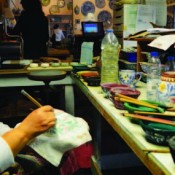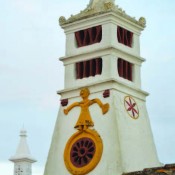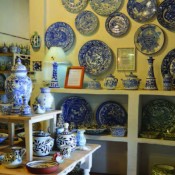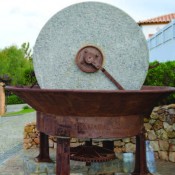



From traditional chimneys to unknown medieval castles, Inside visits Porches’ rich cultural heritage.
This unassuming town, alongside the EN 125, might go unnoticed by some, but there are few places that can lay claim to so many treasures, legends, traditions and such beautiful scenery. Over the years, Porches has proved highly skilled, not only at respecting tradition and authenticity, but also at combining them with the modern world. Its 16.5 square kilometres and its 2,725 inhabitants hold an endless supply of tales to be told.
The fort of Nossa Senhora da Rocha (Our Lady of the Rock), and its small whitewashed chapel overlooking the Atlantic, constitute one of the Algarve’s greatest attractions. Stood on a promontory, the old fort commissioned by King João III protected against pillaging marauders. Old stories say that there was once a kind of “crane” here, with a counterweight, which was used to lift goods out of boats and onto land. Another interesting fact which few are aware of is that inside the chapel, under the altar, there is a hole through which you could hear and see the sea; a kind of passage that connects the chapel over dozens of metres to the sea. This has always been closed, but the hole has been sealed for safety reasons.
The chapel exudes an aura of mystery and its construction date remains unknown to this day. And because legends are part of the intangible heritage, of the memory and identity of the community, legend has it that, “when work first began on building the chapel, the workmen making the initial excavations would leave their tools at the end of each day, only to find they had been moved, further down, to the point of the rock, when they returned following morning. They came to the conclusion that Our Lady didn’t want the chapel there and so they started to build it on the site where their tools appeared every morning. From then on, the tools never disappeared or moved about” (Portuguese Archive of Legends).
The chapel and fort were seriously damaged in the 1755 earthquake, but the chapel was partially restored. Listed as a “building of public interest” since 1963, a research project is still pending to this day.
Few people are aware that there was once a medieval castle in Porches, given the lack of visible remains. José Bentes, the local mayor, laments the lack of interest in exploring such important heritage: “There is still much to study and discover,” he said. In 1911, Ataíde Oliveira wrote in Monografia de Porches: “As the government doesn’t want to spend a penny on prehistoric research, there is no choice but to wait for the property owner to work and turn his lands. And it wouldn’t cost much to find a great abundance of remains of civilisations in the entire area of Porches Velho, Senhora da Rocha, Crastos and Quinta dos Alporchinhos.” More than a century later, such treasures are still waiting to be unearthed.
Another highlight is Porches Parish Church, whose bell tower rises high above the town’s rooftops. Built in the 16th century, it was badly damaged in the 1755 earthquake. However, in 1882, António Joaquim Cabrita donated “4,000 réis”, enabling its reconstruction.
The art of pottery has been practiced since time immemorial. After falling into decline, the tradition was picked up again in the late 1960s by Irish artist Patrick Swift and Lima de Freitas, who founded Olaria Algarvia. As Luís Bentes stressed, “Swift put Porches on the world map”. Today there are several pottery workshops along the EN125, but there are few that still paint the earthenware by hand. One Saturday morning, we met up with Juliet Swift, 56, as she was dealing with the many customers entering the Olaria Algarvia. She and her sister Estella, 46, are the daughters of the Irish artist. Having trained as artists themselves, the two sisters decided to continue the work their father started. And the next generation of potters is secured too, with Juliet’s son now working in the field. On another workbench, Maria Eulália, 58, is painting a piece of earthenware, prior to being glazed. “I’ve been working here for 25 years and I love it. I paint, I deal with customers, I do everything.” While they take in the incredible diversity of pieces of all shapes and colours, the people entering the workshop are a picture of admiration and amazement.
Nearby, under the guiding hand of Scotsman Ian Fitzpatrick, 60, stands the Olaria Pequena, located in an old farmhouse. Ian arrived in the Algarve 34 years ago. A trained artist, he decided to dedicate himself to the pottery tradition of Porches. He and Marco Correia are the mentors behind every item on display. “Every piece is crafted and painted by hand. No two pieces are the same,” reads a sign, as you enter.
Finally, it is impossible to visit Porches without noticing its typical chimneys: original, colourful and very old. Talking about the chimneys, Luís Bentes reveals that the parish council will shortly launch a ‘Porches chimney route’, which will explain their history. “It’s well worth taking a stroll around the town’s streets to admire the old roofs and chimneys. Each one reflects how wealthy the family was,” he explained. One of the most mythical and mysterious can be found above the Casa Museu, in the Rua da Chaminé street. It features a castle keep, a spoked wheel and a human figure, and dates from 1793. In the Travessa do Correio there is another, dating from the 18th century, with four sides. Another highlight is the chimney of the charming Leão de Porches restaurant, located within an impressive restored building, dating from the 18th century. Here we find a lion, crowned with vine leaves. Legend has it that a baby lion appeared in the town many years ago and that it was looked after by the family of this house.
Text & photos Sara Alves













